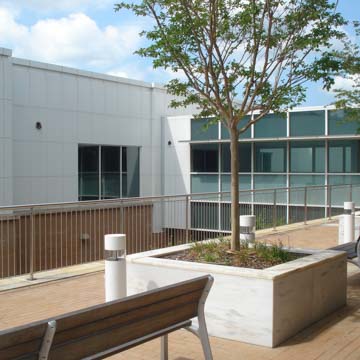The Ernest F. Hollings Special Collections Library is an addition to what was originally the University of South Carolina’s Undergraduate Library but was expanded in the 1970s to become the Thomas Cooper Library. In 2010, the Columbia-based architecture firm Watson Tate Savory built the Hollings Library, which stands as an almost independent pavilion accessed from the Cooper Library via a narrow bridge on its main floor level. This bridge continues an axis running straight through the Cooper Library from its current main entrance, which is situated in the center of the original north window wall. With the extension and therefore the strengthening of this axis, the Cooper Library has lost the last of its modernist sense of space, which had already been diminished by its 1970s renovation.
Just inside the Hollings Library, the axis through the Cooper Library terminates in a spatial dichotomy consisting of two nearly identical suites flanking a weakly asymmetrical foyer. These suites accommodate, respectively, the South Carolina Political Collections and the Special Collections and Rare Books Department. The resulting spatial effect, because it celebrates a dichotomy without resolving it, suggests Mannerism. Meanwhile, the treatment of the Hollings Library’s exterior, particularly on the south facade, appears neo-Baroque.
The historicist strategies evidently brought to bear in designing those aspects of the Hollings Library contrast sharply with the apparently modernist detailing used throughout that facility. At the same time, the commingling of historicism and modernism contextualize it as a continuation of the Undergraduate/Cooper Library both as a building whose polychromy the Hollings Library goes so far as to reproduce, and as an institution whose growing mission begat the Hollings Library’s program. By using both historicist and modernist design approaches, the architects of the Hollings Library played up the stylistic hybridity of the original Undergraduate Library (which started out as both “classical” and “modern”) and also of the Cooper Library as it emerged in the 1970s from what amounted to postmodernist distortions of a modern framework.
The Cooper Library, compromised though its modernism may have been, once counted as one of South Carolina’s exemplary modernist projects. Both spatially and chronologically, but also architecturally, the Hollings Library stands at the end of the Cooper Library. Having formally destroyed with one blow both the Cooper Library’s compromised modernism and its compromising postmodernism, and with its own architectural effects turning on a critical exploration of compromise as such, the Hollings Library now counts as a significant exemplar of South Carolina’s New Modernism.
References
“Ernest F. Hollings Special Collections Library.” Architect Magazine. Accessed May 7, 2019. http://www.architectmagazine.com/.




















